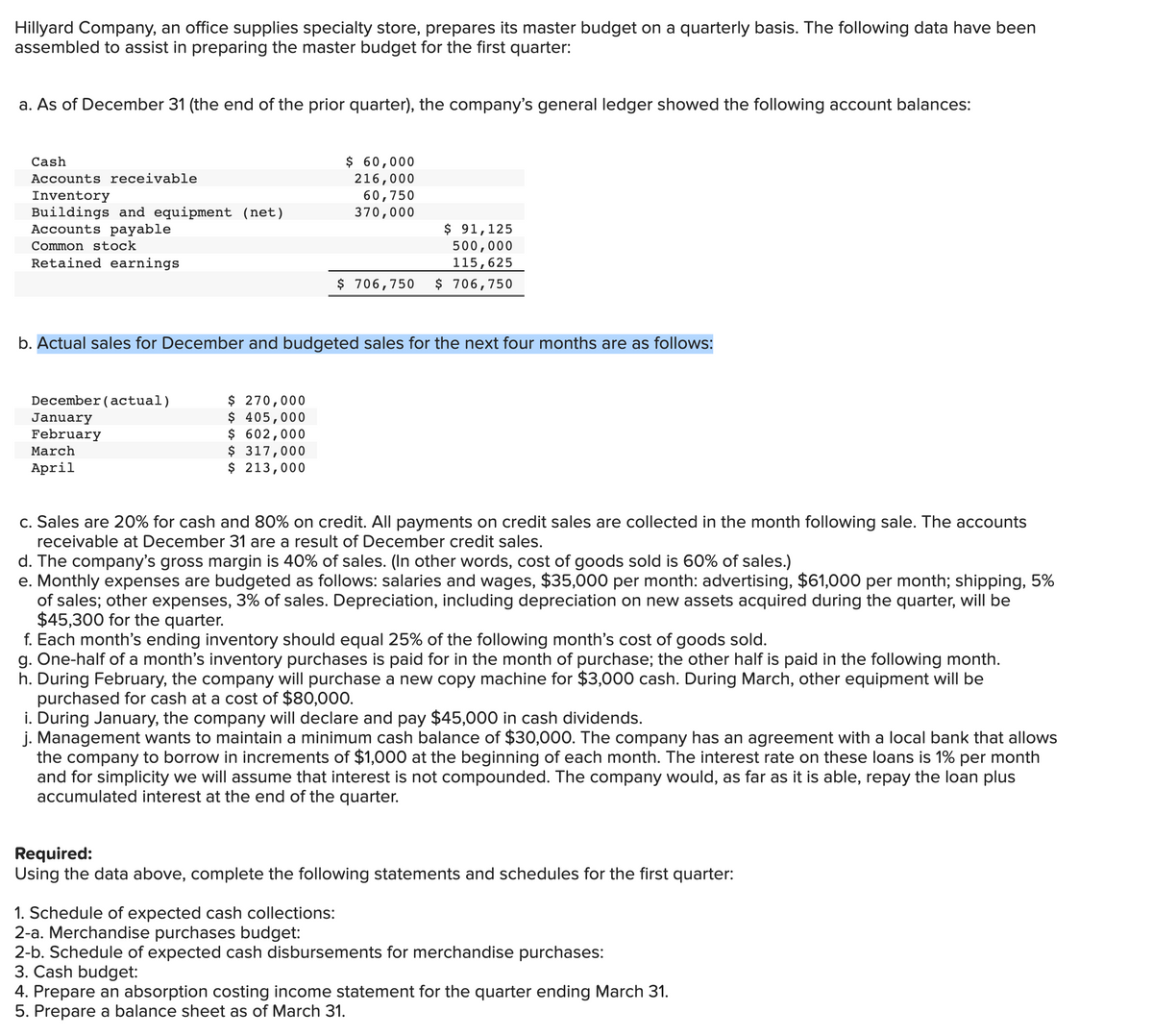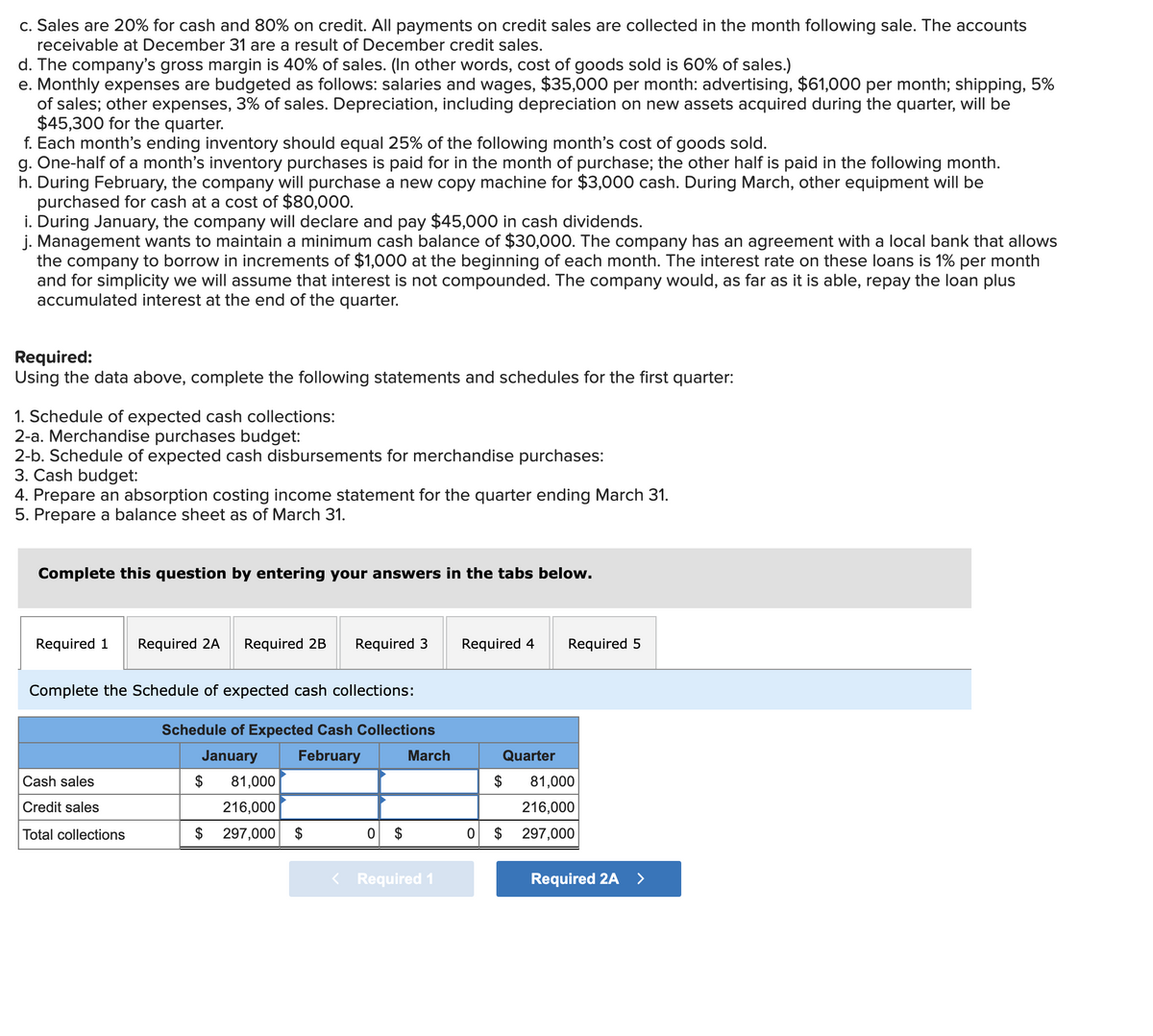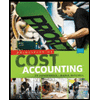Hillyard Company, an office supplies specialty store, prepares its master budget on a quarterly basis. The following data have been assembled to assist in preparing the master budget for the first quarter: a. As of December 31 (the end of the prior quarter), the company's general ledger showed the following account balances: $ 60,000 216,000 60,750 370,000 Cash Accounts receivable Inventory Buildings and equipment (net) Accounts payable Common stock $ 91,125 500,000 115,625 $ 706,750 Retained earnings $ 706,750 b. Actual sales for December and budgeted sales for the next four months are as follows: $ 270,000 $ 405,000 $ 602,000 $ 317,000 $ 213,000 December (actual) January February March April c. Sales are 20% for cash and 80% on credit. All payments on credit sales are collected in the month following sale. The accounts receivable at December 31 are a result of December credit sales. d. The company's gross margin is 40% of sales. (In other words, cost of goods sold is 60% of sales.) e. Monthly expenses are budgeted as follows: salaries and wages, $35,000 per month: advertising, $61,000 per month; shipping, 5% of sales; other expenses, 3% of sales. Depreciation, including depreciation on new assets acquired during the quarter, will be $45,300 for the quarter. f. Each month's ending inventory should equal 25% of the following month's cost of goods sold. g. One-half of a month's inventory purchases is paid for in the month of purchase; the other half is paid in the following month. h. During February, the company will purchase a new copy machine for $3,000 cash. During March, other equipment will be purchased for cash at a cost of $80,000. i. During January, the company will declare and pay $45,000 in cash dividends. j. Management wants to maintain a minimum cash balance of $30,000. The company has an agreement with a local bank that allows the company to borrow in increments of $1,000 at the beginning of each month. The interest rate on these loans is 1% per month and for simplicity we will assume that interest is not compounded. The company would, as far as it is able, repay the loan plus accumulated interest at the end of the quarter. Required: Using the data above, complete the following statements and schedules for the first quarter: 1. Schedule of expected cash collections: 2-a. Merchandise purchases budget: 2-b. Schedule of expected cash disbursements for merchandise purchases: 3. Cash budget: 4. Prepare an absorption costing income statement for the quarter ending March 31. 5 Prepare a balance sheet as of March 31
Hillyard Company, an office supplies specialty store, prepares its master budget on a quarterly basis. The following data have been assembled to assist in preparing the master budget for the first quarter: a. As of December 31 (the end of the prior quarter), the company's general ledger showed the following account balances: $ 60,000 216,000 60,750 370,000 Cash Accounts receivable Inventory Buildings and equipment (net) Accounts payable Common stock $ 91,125 500,000 115,625 $ 706,750 Retained earnings $ 706,750 b. Actual sales for December and budgeted sales for the next four months are as follows: $ 270,000 $ 405,000 $ 602,000 $ 317,000 $ 213,000 December (actual) January February March April c. Sales are 20% for cash and 80% on credit. All payments on credit sales are collected in the month following sale. The accounts receivable at December 31 are a result of December credit sales. d. The company's gross margin is 40% of sales. (In other words, cost of goods sold is 60% of sales.) e. Monthly expenses are budgeted as follows: salaries and wages, $35,000 per month: advertising, $61,000 per month; shipping, 5% of sales; other expenses, 3% of sales. Depreciation, including depreciation on new assets acquired during the quarter, will be $45,300 for the quarter. f. Each month's ending inventory should equal 25% of the following month's cost of goods sold. g. One-half of a month's inventory purchases is paid for in the month of purchase; the other half is paid in the following month. h. During February, the company will purchase a new copy machine for $3,000 cash. During March, other equipment will be purchased for cash at a cost of $80,000. i. During January, the company will declare and pay $45,000 in cash dividends. j. Management wants to maintain a minimum cash balance of $30,000. The company has an agreement with a local bank that allows the company to borrow in increments of $1,000 at the beginning of each month. The interest rate on these loans is 1% per month and for simplicity we will assume that interest is not compounded. The company would, as far as it is able, repay the loan plus accumulated interest at the end of the quarter. Required: Using the data above, complete the following statements and schedules for the first quarter: 1. Schedule of expected cash collections: 2-a. Merchandise purchases budget: 2-b. Schedule of expected cash disbursements for merchandise purchases: 3. Cash budget: 4. Prepare an absorption costing income statement for the quarter ending March 31. 5 Prepare a balance sheet as of March 31
Cornerstones of Cost Management (Cornerstones Series)
4th Edition
ISBN:9781305970663
Author:Don R. Hansen, Maryanne M. Mowen
Publisher:Don R. Hansen, Maryanne M. Mowen
Chapter8: Budgeting For Planning And Control
Section: Chapter Questions
Problem 11CE: Shalimar Company manufactures and sells industrial products. For next year, Shalimar has budgeted...
Related questions
Question
I need help with this one please thank you

Transcribed Image Text:Hillyard Company, an office supplies specialty store, prepares its master budget on a quarterly basis. The following data have been
assembled to assist in preparing the master budget for the first quarter:
a. As of December 31 (the end of the prior quarter), the company's general ledger showed the following account balances:
$ 60,000
216,000
60,750
370,000
Cash
Accounts receivable
Inventory
Buildings and equipment (net)
Accounts payable
$ 91,125
500,000
115,625
$ 706,750
Common stock
Retained earnings
$ 706,750
b. Actual sales for December and budgeted sales for the next four months are as follows:
$ 270,000
$ 405,000
$ 602,000
$ 317,000
$ 213,000
December(actual)
January
February
March
April
c. Sales are 20% for cash and 80% on credit. All payments on credit sales are collected in the month following sale. The accounts
receivable at December 31 are a result of December credit sales.
d. The company's gross margin is 40% of sales. (In other words, cost of goods sold is 60% of sales.)
e. Monthly expenses are budgeted as follows: salaries and wages, $35,000 per month: advertising, $61,000 per month; shipping, 5%
of sales; other expenses, 3% of sales. Depreciation, including depreciation on new assets acquired during the quarter, will be
$45,300 for the quarter.
f. Each month's ending inventory should equal 25% of the following month's cost of goods sold.
g. One-half of a month's inventory purchases is paid for in the month of purchase; the other half is paid in the following month.
h. During February, the company will purchase a new copy machine for $3,000 cash. During March, other equipment will be
purchased for cash at a cost of $80,000.
i. During January, the company will declare and pay $45,000 in cash dividends.
j. Management wants to maintain a minimum cash balance of $30,000. The company has an agreement with a local bank that allows
the company to borrow in increments of $1,000 at the beginning of each month. The interest rate on these loans is 1% per month
and for simplicity we will assume that interest is not compounded. The company would, as far as it is able, repay the loan plus
accumulated interest at the end of the quarter.
Required:
Using the data above, complete the following statements and schedules for the first quarter:
1. Schedule of expected cash collections:
2-a. Merchandise purchases budget:
2-b. Schedule of expected cash disbursements for merchandise purchases:
3. Cash budget:
4. Prepare an absorption costing income statement for the quarter ending March 31.
5. Prepare a balance sheet as of March 31.

Transcribed Image Text:c. Sales are 20% for cash and 80% on credit. All payments on credit sales are collected in the month following sale. The accounts
receivable at December 31 are a result of December credit sales.
d. The company's gross margin is 40% of sales. (In other words, cost of goods sold is 60% of sales.)
e. Monthly expenses are budgeted as follows: salaries and wages, $35,000 per month: advertising, $61,000 per month; shipping, 5%
of sales; other expenses, 3% of sales. Depreciation, including depreciation on new assets acquired during the quarter, will be
$45,300 for the quarter.
f. Each month's ending inventory should equal 25% of the following month's cost of goods sold.
g. One-half of a month's inventory purchases is paid for in the month of purchase; the other half is paid in the following month.
h. During February, the company will purchase a new copy machine for $3,000 cash. During March, other equipment will be
purchased for cash at a cost of $80,000.
i. During January, the company will declare and pay $45,000 in cash dividends.
j. Management wants to maintain a minimum cash balance of $30,000. The company has an agreement with a local bank that allows
the company to borrow in increments of $1,000 at the beginning of each month. The interest rate on these loans is 1% per month
and for simplicity we will assume that interest is not compounded. The company would, as far as it is able, repay the loan plus
accumulated interest at the end of the quarter.
Required:
Using the data above, complete the following statements and schedules for the first quarter:
1. Schedule of expected cash collections:
2-a. Merchandise purchases budget:
2-b. Schedule of expected cash disbursements for merchandise purchases:
3. Cash budget:
4. Prepare an absorption costing income statement for the quarter ending March 31.
5. Prepare a balance sheet as of March 31.
Complete this question by entering your answers in the tabs below.
Required 1
Required 2A
Required 2B
Required 3
Required 4
Required 5
Complete the Schedule of expected cash collections:
Schedule of Expected Cash Collections
January
February
March
Quarter
Cash sales
$
81,000
$
81,000
Credit sales
216,000
216,000
Total collections
$ 297,000 $
0 $
$ 297,000
< Required 1
Required 2A
>
Expert Solution
Step 1
| 1) | Schedule of Expected cash collections | |||||
| January | Feburary | March | Quarter | |||
| Cash sales | $ 81,000 | $ 120,400 | $ 63,400 | $ 264,800 | ||
| Credit sales | $ 216,000 | $ 324,000 | $ 481,600 | $ 1,021,600 | ||
| total collections | $ 297,000 | $ 444,400 | $ 545,000 | $ 1,286,400 | ||
| Accounts receivable at march 31= 317,000*80%=253,600 | ||||||
| 2-a) | Merchandise purchase budget | |||||
| January | Feburary | March | Quarter | |||
| budgeted cost of goods sold | $ 243,000 | $ 361,200 | $ 190,200 | $ 794,400 | ||
| Add:Ending inventory | $ 90,300 | $ 47,550 | $ 31,950 | $ 31,950 | ||
| total needs | $ 333,300 | $ 408,750 | $ 222,150 | $ 826,350 | ||
| less Beginning inventory | $ 60,750 | $ 90,300 | $ 47,550 | $ 60,750 | ||
| Required purchases | $ 272,550 | $ 318,450 | $ 174,600 | $ 765,600 | ||
| 2-b) | Schedule of Expected cash disbursement for Merchandise purchase | |||||
| January | Feburary | March | Quarter | |||
| December purchases | $ 91,125 | $ 91,125 | ||||
| january purchases | $ 136,275 | $ 136,275 | $ 272,550 | |||
| Feburary purchases | $ 159,225 | $ 159,225 | $ 318,450 | |||
| march purchases | $ 87,300 | $ 87,300 | ||||
| total cash disbursement for purchases | $ 227,400 | $ 295,500 | $ 246,525 | $ 769,425 | ||
| Accounts payable= | 87,300 | |||||
| Hillyard Company | ||||||
| 3) | Cash budget | |||||
| January | Feburary | March | Quarter | |||
| Beginning cash balance | $ 60,000 | $ 30,200 | $ 31,940 | $ 60,000 | ||
| Add cash collections | $ 297,000 | $ 444,400 | $ 545,000 | $ 1,286,400 | ||
| total cash available | $ 357,000 | $ 474,600 | $ 576,940 | $ 1,346,400 | ||
| less cash disbursements | ||||||
| purchase of inventory | $ 227,400 | $ 295,500 | $ 246,525 | $ 769,425 | ||
| selling and adm expense | $ 128,400 | $ 144,160 | $ 121,360 | $ 393,920 | ||
| purchase of equipment | $ - | $ 3,000 | $ 80,000 | $ 83,000 | ||
| cash dividends | $ 45,000 | $ - | $ - | $ 45,000 | ||
| total cash disbursement | $ 400,800 | $ 442,660 | $ 447,885 | $ 1,291,345 | ||
| Excess(Deficiency) of cash | $ (43,800) | $ 31,940 | $ 129,055 | $ 55,055 | ||
| Financing | ||||||
| Borrowings | $ 74,000 | $ - | $ - | $ 74,000 | ||
| Repayments | $ - | $ - | $ (74,000) | $ (74,000) | ||
| interest | $ - | $ - | $ (2,220) | $ (2,220) | ||
| $ - | $ - | $ - | $ - | |||
| total financing | $ 74,000 | $ - | $ (76,220) | $ (2,220) | ||
| ending cash balance | $ 30,200 | $ 31,940 | $ 52,835 | $ 52,835 | ||
| interest expense = 74000*1%*3 | ||||||
| $ 2,220 | ||||||
| 4) | Hillyard Company | |||||
| Income Statement | ||||||
| For the Quarter Ended March 31 | ||||||
| Sales | (405,000+602000+317000) | $ 1,324,000 | ||||
| cost of goods sold | ||||||
| Beginning invnetory | $ 60,750 | |||||
| Add purchases | $ 765,600 | |||||
| cost of goods avaialble | $ 826,350 | |||||
| less ending inventory | $ 31,950 | $ 794,400 | ||||
| Gross profit | $ 529,600 | |||||
| Selling and administrative exp | ||||||
| Salaries and wages | (35000*3) | $ 105,000 | ||||
| Advertising | (61000*3) | $ 183,000 | ||||
| shiiping 5% of sales | $ 66,200 | |||||
| other expense 3% of sales | $ 39,720 | |||||
| Depreciation | $ 45,300 | $ 439,220 | ||||
| operating income | $ 90,380 | |||||
| less interest expense | $ 2,220 | |||||
| Net income | $ 88,160 | |||||
| 5) | Hillyard Company | |||||
| Balance sheet | ||||||
| 31-Mar | ||||||
| Assets | ||||||
| current assets | ||||||
| cash | $ 52,835 | |||||
| Account receivable | $ 253,600 | |||||
| inventory | $ 31,950 | |||||
| total current assets | $ 338,385 | |||||
| buildings and Equipment (net) | (370,000+3,000+80,000-45300) | $ 407,700 | ||||
| total assets | $ 746,085 | |||||
| liabilities & stockholders Equity | ||||||
| current liabilities | ||||||
| Accounts payable | $ 87,300 | |||||
| total current liabilities | $ 87,300 | |||||
| Stockholders Equity | ||||||
| common stock | $ 500,000 | |||||
| Retained earnings | (115625+88160-45000) | $ 158,785 | ||||
| total stockholders equity | $ 658,785 | |||||
| total liabilities & stockholders equity | $ 746,085 | |||||
Trending now
This is a popular solution!
Step by step
Solved in 5 steps with 4 images

Recommended textbooks for you

Cornerstones of Cost Management (Cornerstones Ser…
Accounting
ISBN:
9781305970663
Author:
Don R. Hansen, Maryanne M. Mowen
Publisher:
Cengage Learning

Managerial Accounting
Accounting
ISBN:
9781337912020
Author:
Carl Warren, Ph.d. Cma William B. Tayler
Publisher:
South-Western College Pub

Financial And Managerial Accounting
Accounting
ISBN:
9781337902663
Author:
WARREN, Carl S.
Publisher:
Cengage Learning,

Cornerstones of Cost Management (Cornerstones Ser…
Accounting
ISBN:
9781305970663
Author:
Don R. Hansen, Maryanne M. Mowen
Publisher:
Cengage Learning

Managerial Accounting
Accounting
ISBN:
9781337912020
Author:
Carl Warren, Ph.d. Cma William B. Tayler
Publisher:
South-Western College Pub

Financial And Managerial Accounting
Accounting
ISBN:
9781337902663
Author:
WARREN, Carl S.
Publisher:
Cengage Learning,

EBK CONTEMPORARY FINANCIAL MANAGEMENT
Finance
ISBN:
9781337514835
Author:
MOYER
Publisher:
CENGAGE LEARNING - CONSIGNMENT

Managerial Accounting: The Cornerstone of Busines…
Accounting
ISBN:
9781337115773
Author:
Maryanne M. Mowen, Don R. Hansen, Dan L. Heitger
Publisher:
Cengage Learning

Principles of Cost Accounting
Accounting
ISBN:
9781305087408
Author:
Edward J. Vanderbeck, Maria R. Mitchell
Publisher:
Cengage Learning